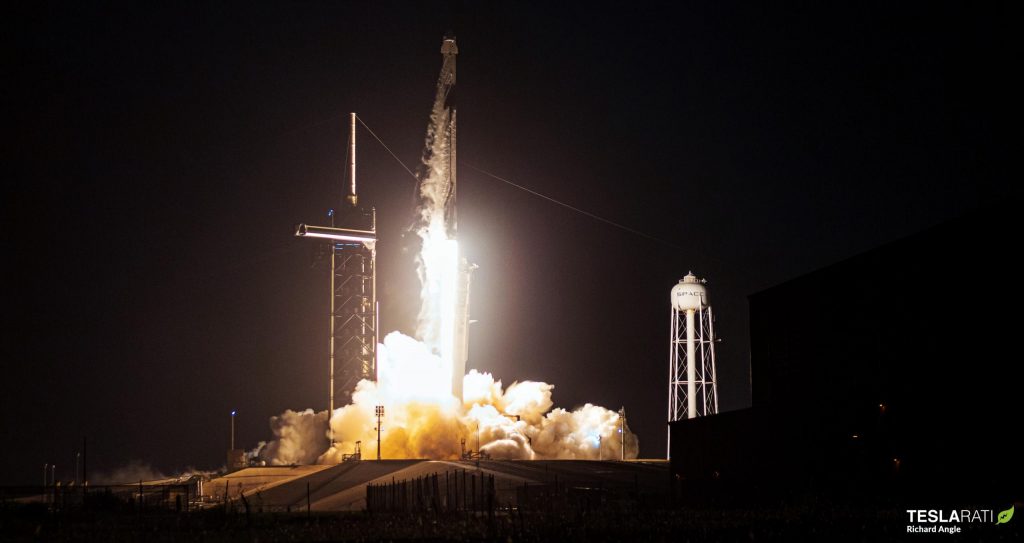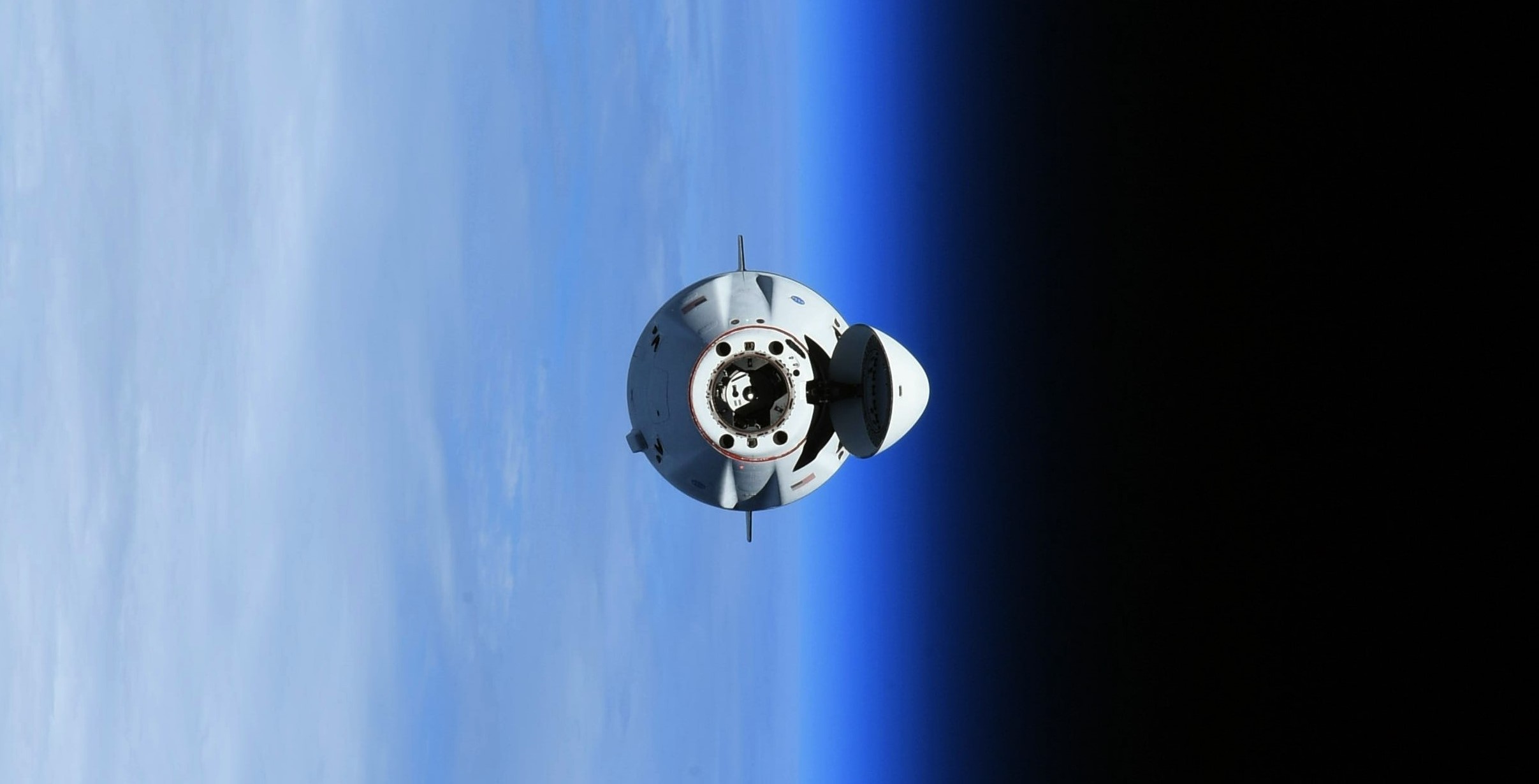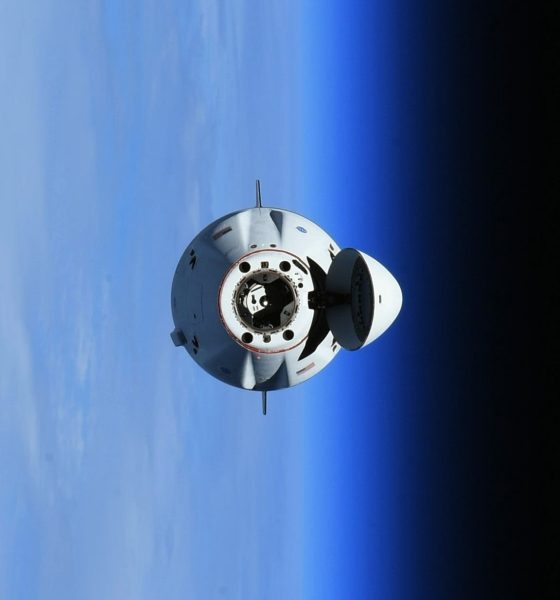For the fourth time in nine months, SpaceX has docked a Dragon spacecraft to the International Space Station with a second Dragon already present at the crewed orbital laboratory.
Launched Saturday on a Falcon 9 rocket after a one-day weather delay, SpaceX’s first upgraded Cargo Dragon 2 spacecraft gradually boosted and tweaked its orbit over the course of ~30 hours, looping around the Earth 20+ times before docking with the ISS more than half an hour ahead of schedule. Dragon’s Monday, August 30th arrival marked cargo capsule C208’s second space station docking in nine months, smashing SpaceX and the world’s turnaround record for a reusable orbital space capsule – of which Dragons are the only still flying.
SpaceX’s first twice-flown Crew Dragon was there to greet the first twice-flown Cargo Dragon 2 spacecraft when it docked, having spent the last four months in orbit in support of NASA’s second operational commercial crew mission (Crew-2). A similar instance of a pair Dragons meeting in space is likely to occur at least two more times before the end of 2021.


The first two-Dragons-one-ISS instance occurred just nine months ago when the very same Cargo Dragon 2 spacecraft (capsule C208) rendezvoused and docked with the ISS with SpaceX’s Crew-1 Crew Dragon already attached. At the time, in a number of press conferences and public statements centered around the launch of Crew-1 and CRS-21, SpaceX repeatedly hinted at just how prolific a year 2021 would be for Dragon and it’s hard to argue that the company was exaggerating.
Indeed, exactly as SpaceX foretold, Dragon spacecraft have maintained a continuous presence in orbit and repeatedly operated side by side at the ISS since Crew-1’s November 2021 launch. For the majority of NASA’s Commercial Crew Program development, that degree of continuous, single-provider operations was never meant to happen. SpaceX’s upgraded Cargo Dragon, for example, is one of two independent Commercial Resupply Services (CRS) spacecraft that regularly resupply the space station, ensuring redundancy in the event that one spacecraft or rocket runs into major issues. A third CRS vehicle – Sierra Nevada’s Dream Chaser spaceplane – will also begin cargo deliveries sometime next year.
NASA’s Commercial Crew Program was structured in the same way, with Boeing and SpaceX serving as two redundant crew transport providers. Of course, things didn’t go exactly according to plan and Boeing – despite receiving 60% (~$2B) more funding than SpaceX – has suffered numerous catastrophic issues in recent years, nearly dooming its Starliner spacecraft’s first uncrewed launch in December 2019 and ultimately delaying the company by two or more years.
After further issues delayed Starliner’s uncrewed do-over test flight (OFT-2) from August to late 2021 or early 2022, it’s entirely possible that SpaceX will operate as NASA’s sole crew transport solution for more than 18 months before Boeing flies a single astronaut. In other words, it’s likely that SpaceX will need to maintain the extraordinary cadence of Dragon launches demonstrated in 2021 well into 2022, and possibly even 2023. Since November 2020, SpaceX has launched three Cargo Dragon 2 resupply missions and eight astronauts on two Crew Dragons.
Another two NASA Dragon missions – Crew-3 and CRS-24 – are scheduled to launch in October and December 2021 and SpaceX’s first fully private Inspiration4 Crew Dragon launch could happen as early as September 15th. So long as Boeing’s Starliner is unable to fulfill its crew transport role, all future SpaceX Crew and Cargo missions for NASA – including Crew-3 and CRS-24 – will continue to see one Dragon meet another at the ISS. All told, barring possible delays to CRS-24, SpaceX is on track to launch eight Dragons – four Crew and four Cargo; 16 astronauts and 11 tons of space station supplies – in 13 months.
If Crew Dragon and Cargo Dragon 2 are considered to be two variants of the same Dragon 2 spacecraft, the only other instance in history where another orbital spacecraft came close to eight successful orbital launches in ~13 months was NASA’s Gemini Program, which completed eight crewed test flights in ~14 months in 1965 and 1966.
NASA’s Apollo spacecraft also completed six successful flights (5 crewed, 1 uncrewed) in 13 months in 1968 and 1969. Russian Soyuz vehicles – the most prolific crewed spacecraft in history – have also successfully flown 8 times in 13 months and 9 times in 14 months in the 1970s. Put simply, SpaceX’s Dragon program is now singlehandedly executing at or above the level of the two most prolific national space programs in history at funding peaks that haven’t been touched since and for a fraction of the cost.

News
Tesla Full Self-Driving v14.2 – Full Review, the Good and the Bad

Tesla rolled out Full Self-Driving version 14.2 yesterday to members of the Early Access Program (EAP). Expectations were high, and Tesla surely delivered.
With the rollout of Tesla FSD v14.2, there were major benchmarks for improvement from the v14.1 suite, which spanned across seven improvements. Our final experience with v14.1 was with v14.1.7, and to be honest, things were good, but it felt like there were a handful of regressions from previous iterations.
While there were improvements in brake stabbing and hesitation, we did experience a few small interventions related to navigation and just overall performance. It was nothing major; there were no critical takeovers that required any major publicity, as they were more or less subjective things that I was not particularly comfortable with. Other drivers might have been more relaxed.
With v14.2 hitting our cars yesterday, there were a handful of things we truly noticed in terms of improvement, most notably the lack of brake stabbing and hesitation, a major complaint with v14.1.x.
However, in a 62-minute drive that was fully recorded, there were a lot of positives, and only one true complaint, which was something we haven’t had issues with in the past.
The Good
Lack of Brake Stabbing and Hesitation
Perhaps the most notable and publicized issue with v14.1.x was the presence of brake stabbing and hesitation. Arriving at intersections was particularly nerve-racking on the previous version simply because of this. At four-way stops, the car would not be assertive enough to take its turn, especially when other vehicles at the same intersection would inch forward or start to move.
This was a major problem.
However, there were no instances of this yesterday on our lengthy drive. It was much more assertive when arriving at these types of scenarios, but was also more patient when FSD knew it was not the car’s turn to proceed.
Can report on v14.2 today there were ZERO instances of break stabbing or hesitation at intersections today
It was a significant improvement from v14.1.x
— TESLARATI (@Teslarati) November 21, 2025
This improvement was the most noticeable throughout the drive, along with fixes in overall smoothness.
Speed Profiles Seem to Be More Reasonable
There were a handful of FSD v14 users who felt as if the loss of a Max Speed setting was a negative. However, these complaints will, in our opinion, begin to subside, especially as things have seemed to be refined quite nicely with v14.2.
Freeway driving is where this is especially noticeable. If it’s traveling too slow, just switch to a faster profile. If it’s too fast, switch to a slower profile. However, the speeds seem to be much more defined with each Speed Profile, which is something that I really find to be a huge advantage. Previously, you could tell the difference in speeds, but not in driving styles. At times, Standard felt a lot like Hurry. Now, you can clearly tell the difference between the two.
It seems as if Tesla made a goal that drivers should be able to tell which Speed Profile is active if it was not shown on the screen. With v14.1.x, this was not necessarily something that could be done. With v14.2, if someone tested me on which Speed Profile was being used, I’m fairly certain I could pick each one.
Better Overall Operation
I felt, at times, especially with v14.1.7, there were some jerky movements. Nothing that was super alarming, but there were times when things just felt a little more finicky than others.
v14.2 feels much smoother overall, with really great decision-making, lane changes that feel second nature, and a great speed of travel. It was a very comfortable ride.
The Bad
Parking
It feels as if there was a slight regression in parking quality, as both times v14.2 pulled into parking spots, I would have felt compelled to adjust manually if I were staying at my destinations. For the sake of testing, at my first destination, I arrived, allowed the car to park, and then left. At the tail-end of testing, I walked inside the store that FSD v14.2 drove me to, so I had to adjust the parking manually.
This was pretty disappointing. Apart from parking at Superchargers, which is always flawless, parking performance is something that needs some attention. The release notes for v14.2. state that parking spot selection and parking quality will improve with future versions.
Any issues with parking on your end? 14.1.7 didn’t have this trouble with parking pic.twitter.com/JPLRO2obUj
— TESLARATI (@Teslarati) November 21, 2025
However, this was truly my only complaint about v14.2.
You can check out our full 62-minute ride-along below:
Elon Musk
SpaceX issues statement on Starship V3 Booster 18 anomaly
The incident unfolded during gas-system pressure testing at the company’s Massey facility in Starbase, Texas.

SpaceX has issued an initial statement about Starship Booster 18’s anomaly early Friday. The incident unfolded during gas-system pressure testing at the company’s Massey facility in Starbase, Texas.
SpaceX’s initial comment
As per SpaceX in a post on its official account on social media platform X, Booster 18 was undergoing gas system pressure tests when the anomaly happened. Despite the nature of the incident, the company emphasized that no propellant was loaded, no engines were installed, and personnel were kept at a safe distance from the booster, resulting in zero injuries.
“Booster 18 suffered an anomaly during gas system pressure testing that we were conducting in advance of structural proof testing. No propellant was on the vehicle, and engines were not yet installed. The teams need time to investigate before we are confident of the cause. No one was injured as we maintain a safe distance for personnel during this type of testing. The site remains clear and we are working plans to safely reenter the site,” SpaceX wrote in its post on X.
Incident and aftermath
Livestream footage from LabPadre showed Booster 18’s lower half crumpling around the liquid oxygen tank area at approximately 4:04 a.m. CT. Subsequent images posted by on-site observers revealed extensive deformation across the booster’s lower structure. Needless to say, spaceflight observers have noted that Booster 18 would likely be a complete loss due to its anomaly.
Booster 18 had rolled out only a day earlier and was one of the first vehicles in the Starship V3 program. The V3 series incorporates structural reinforcements and reliability upgrades intended to prepare Starship for rapid-reuse testing and eventual tower-catch operations. Elon Musk has been optimistic about Starship V3, previously noting on X that the spacecraft might be able to complete initial missions to Mars.
Investor's Corner
Tesla analyst maintains $500 PT, says FSD drives better than humans now
The team also met with Tesla leaders for more than an hour to discuss autonomy, chip development, and upcoming deployment plans.

Tesla (NASDAQ:TSLA) received fresh support from Piper Sandler this week after analysts toured the Fremont Factory and tested the company’s latest Full Self-Driving software. The firm reaffirmed its $500 price target, stating that FSD V14 delivered a notably smooth robotaxi demonstration and may already perform at levels comparable to, if not better than, average human drivers.
The team also met with Tesla leaders for more than an hour to discuss autonomy, chip development, and upcoming deployment plans.
Analysts highlight autonomy progress
During more than 75 minutes of focused discussions, analysts reportedly focused on FSD v14’s updates. Piper Sandler’s team pointed to meaningful strides in perception, object handling, and overall ride smoothness during the robotaxi demo.
The visit also included discussions on updates to Tesla’s in-house chip initiatives, its Optimus program, and the growth of the company’s battery storage business. Analysts noted that Tesla continues refining cost structures and capital expenditure expectations, which are key elements in future margin recovery, as noted in a Yahoo Finance report.
Analyst Alexander Potter noted that “we think FSD is a truly impressive product that is (probably) already better at driving than the average American.” This conclusion was strengthened by what he described as a “flawless robotaxi ride to the hotel.”
Street targets diverge on TSLA
While Piper Sandler stands by its $500 target, it is not the highest estimate on the Street. Wedbush, for one, has a $600 per share price target for TSLA stock.
Other institutions have also weighed in on TSLA stock as of late. HSBC reiterated a Reduce rating with a $131 target, citing a gap between earnings fundamentals and the company’s market value. By contrast, TD Cowen maintained a Buy rating and a $509 target, pointing to strong autonomous driving demonstrations in Austin and the pace of software-driven improvements.
Stifel analysts also lifted their price target for Tesla to $508 per share over the company’s ongoing robotaxi and FSD programs.










